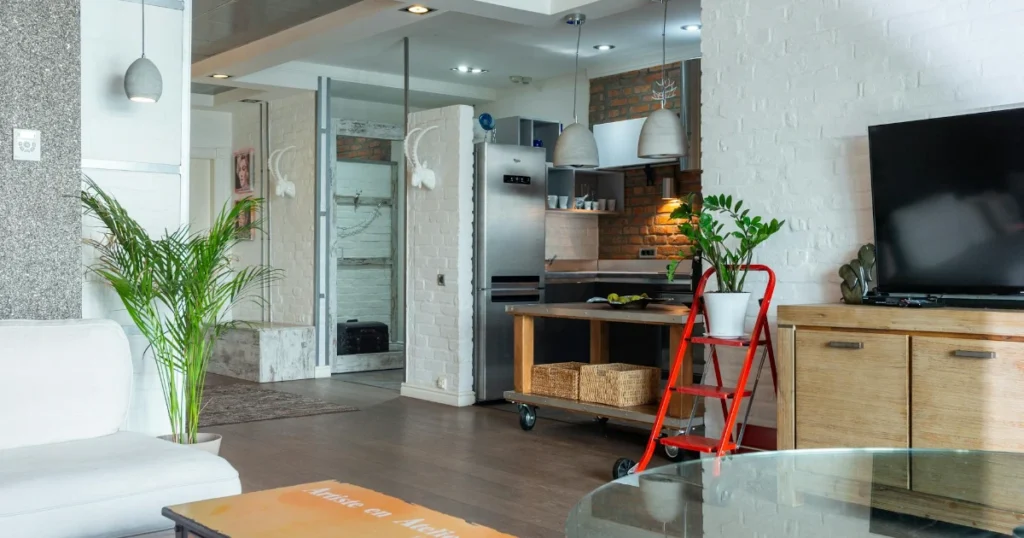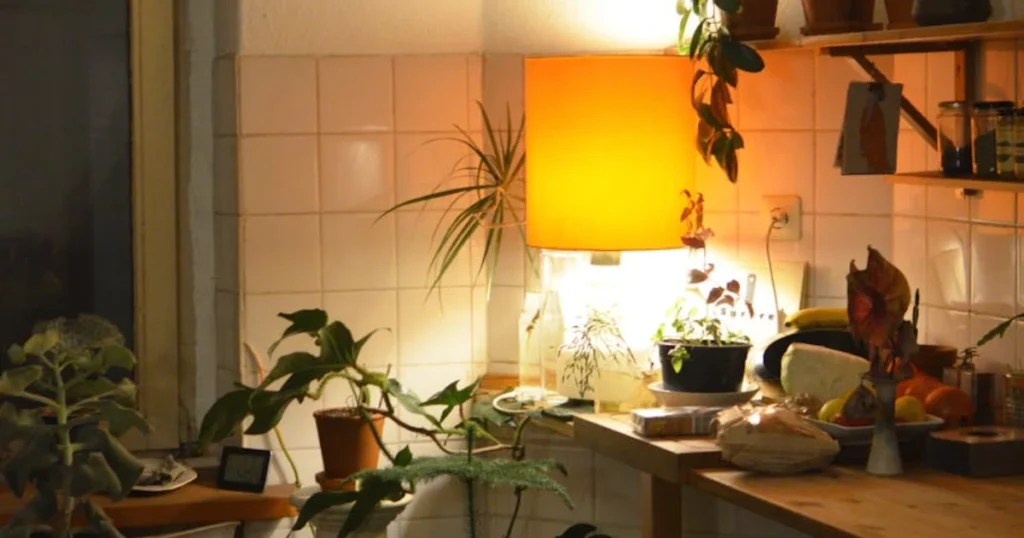Want to brighten your kitchen? Add lots of lighting in layers and control each layer individually using these kitchen lighting ideas.
When it comes to lighting in the kitchen, the general advice is to add lots, but to do so in layers. It is important to make sure to control each of these layers individually.
Lighting can be broken down into three main sections: ambient, task, and decorative.
Ambient Lighting
The types of lighting in each of these sections should be considered from both a practical and aesthetic point of view. Ambient lighting is the main lighting in the ceiling. This is typically LED recessed lights or pot lights. This lighting covers the whole room and gives that general overall coverage for the kitchen.
There are a couple of things to consider with these lights, most notably where to position them and how many are needed.
Determining the Number of Lights
The aim with ambient light is to flood the room evenly with light. Enough lights are needed to cover the room. However, avoid so many that the light itself is overlapping on one another. It should not feel like standing on the surface of the sun.
The size and shape of the room, as well as the kitchen layout, needs to be considered to determine where to place these lights. The size of the downlights themselves also needs consideration. The larger the diameter, the bigger the light coverage from them.
Therefore, fewer lights might be needed, or they might be spaced out slightly further apart and still achieve the same coverage. The ceiling, where the joists are, as well as any architectural features such as beams or skylights, also need consideration. This might restrict where the downlights can physically be installed.
Positioning
It is usually best to start with the first row of lighting off from the wall. A good general rule is to try and position these lights in line with the edge of the countertop. This is about 60 centimeters or about 24 inches off the wall.
This is for two reasons:
- It’s far enough in front of any wall cabinets that the light will actually light the whole of the wall cabinet and not just a small part where the light gets cut off if it’s too close.
- It’s not too far off the wall that when standing and working at the countertop, the lights are behind, creating a shadow while working.
This 60 centimeters or about 24 inches is really the sweet spot for this row of lighting. From there, work along the kitchen run and spread the lights anywhere from 90 centimeters up to a meter and a half (sort of three to five feet). Make sure that none of the lights are closer than that 60 centimeters (24 inches) to any kitchen wall.
There is a loose rule where the ceiling height can be divided by two, and that gives the distance to space the lights out. For example, if there is an eight-foot ceiling, space the lights four feet apart.

Task Lighting
There are two types of lighting considered to be task lighting: under-cabinet lighting and pendant lighting. Pendant lighting could also be described as decorative too, but it should focus as task lighting foremost.
Under-Cabinet Lighting
Under-cabinet lighting can be really important for a functional kitchen. It gives that extra light needed for doing those day-to-day tasks like actually prepping and cooking food. While the ambient lighting is correctly installed above, it’s higher up in the ceiling, and the light is generally much softer by the time it comes down and reaches the countertop.
By adding under-cabinet lighting, much more direct and intentional lighting is achieved in the areas that will be worked in the most, making it a very practical lighting source. There are lots of different under-cabinet lighting options on the market, from LED color-changing strips to individual lights fitted at the back of the wall cabinets and even recessed lights in them as well.
The type of lighting will ultimately come down to what’s available for the particular type of kitchen that is being installed, as well as just personal preference. LED strip lighting is a good option. They give a better, more even, and wider light coverage rather than any individual lights or spots that might just give pockets of light.
It is always recommended to get under-cabinet lighting of some description. If designing a new kitchen, plan this in early so the electrician can get the wires in place. If retrofitting some under-cabinet lighting, the wiring may be able to be hidden, or it might have to be surface mounted. Lights that can just clip on and are battery operated are also an option. They can be operated with a remote.
Pendant Lights
Pendant lights over a kitchen island or peninsula bring that more intense lighting down closer to the countertops, giving more practical task lighting. Exactly how close to the countertop or how far up above it depends on height and, to some extent, the height of the ceilings. Pendant lights should hang down from the ceiling enough to create that practical task lighting, as well as to create that feature look, but not so far down that the light fixtures themselves are blocking any sight lines through the kitchen or are just right in the face while working.
The general rule is to position the bottom of the light fixture somewhere between 75 to 90 centimeters or 30 to 36 inches above the countertop. Somewhere around that point is usually good for most people. The exact height will depend on height. It’s a kitchen, and it needs to work for the user.
Pendant lighting can be viewed as decorative, and it’s a great way to add some visual interest to a kitchen or help achieve a particular style or aesthetic.
Decorative Lighting
Decorative lighting would be anything like in-cabinet lights for glass-fronted wall cabinets or internal draw lighting or lighting inside a ladder cupboard, as well as things like strip lighting underneath the countertop at the front edge of the cabinets or things like plinth lighting. So where the strip light is underneath the bottom of the base cabinet or even individual lights cut into the plinth itself.
Any additional lighting in a kitchen that isn’t directly designed or used for tasks and could be classed as more non-essential falls into this category. These types of lighting are really more style and aesthetics-focused and just that cherry on top of an overall kitchen design. But just because they’re more decorative doesn’t mean that they shouldn’t be included.
These types of details can really elevate a kitchen or any space and create a real wow factor and make the kitchen a more joyful user experience.

Top Tips
Probably the most important one is to have individual controls or switches for each of the types of lighting that are available. Lighting is all about layers, and each layer needs to be able to be controlled individually. There should not be just one light switch in the kitchen that turns everything on and off all together.
Create separate switches for the ambient ceiling lights. Maybe even two switches depending on how big the room is and how many lights there are. Then separate switches for any pendant lights, under-cabinet lights, and any other decorative lights that might be available.
Another tip is to consider installing dimmable lighting. This is all about controlling the lighting environment. Dimmable lighting could be added everywhere for ultimate control, or maybe just to the pendant lights. Make sure that any small lamps or bulbs, especially LEDs, are dimmable and that the correct dimmable switches are installed for everything as well.
Go with white-finished recessed lighting or pot lights. Recessed ceiling lights can be purchased in a whole host of different finishes like stainless steel, brass, and black. If you like these and it works for the look, then go for it. It is recommended to go with a plain white finish. Most people will be painting their ceiling white, and by having a white finish, the lights seem to just blend in with the ceiling.
There are even smart lights or bulbs out there that can be used that will change their color temperature, so something else to consider if ultimate flexibility and lighting design and control is desired.
Conclusion
By layering different types of kitchen lighting, including ambient, task, and decorative options, and utilizing controls to adjust brightness and color temperature, anyone can create a well-lit and inviting kitchen space.